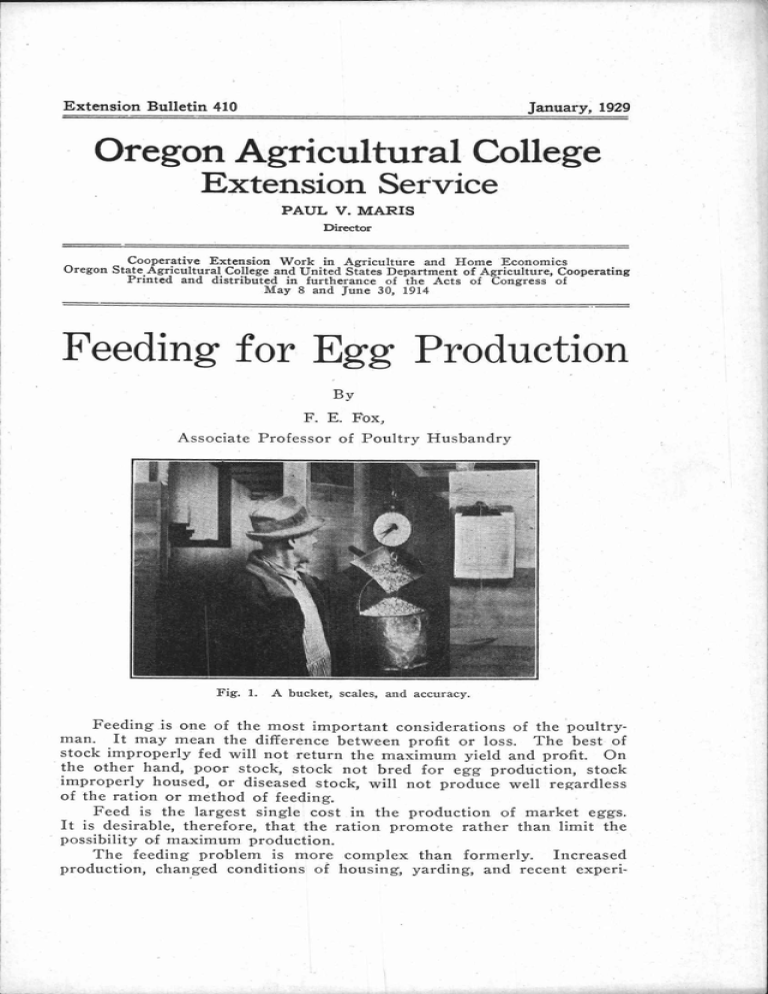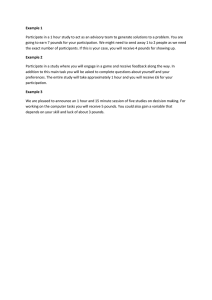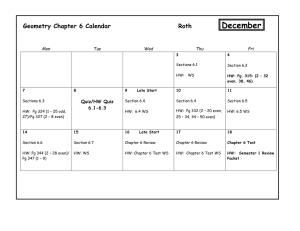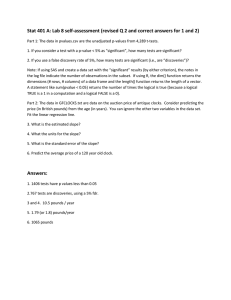Oregon Agricultural College Extension Service
advertisement

Extension Bulletin 410 January, 1929 Oregon Agricultural College Extension Service PAUL V. MARIS Director Cooperative Extension Work in Agriculture and Home Economics Printed and distributed in furtherance of the Acts of Congress of Oregon State Agricultural College and United States Department of Agriculture, Cooperating May 8 and June 30, 1914 Feeding for Egg Production By F. E. Fox, Associate Professor of Poultry Husbandry Fig. 1. A bucket, scales, and accuracy. Feeding is one of the most important considerations of the poultryIt may mean the difference between profit or loss. The best of stock improperly fed will not return the maximum yield and profit. On man. the other hand, poor stock, stock not bred for egg production, stock improperly housed, or diseased stock, will not produce well regardless of the ration or method of feeding. Feed is the largest single cost in the production of market eggs. It is desirable, therefore, that the ration promote rather than limit the possibility of maximum production. The feeding problem is more complex than formerly. Increased production, changed conditions of housing, yarding, and recent experi- 2 EXTENSION SERVICE BULLETIN 410 mental findings in the nutrition field demand greater efficiency in feeding. The right kind of feeding, under various conditions, will increase production and profits. Feeding not only affects the quantity of eggs but also the quality, and even the size. A large amount of highly pigmented feeds such as green feeds, yellow corn, certain weeds like shepherd's-purse, etc., will give a deeper yellow color to the yolk of the egg. A large amount of onions or fish scrap will flavor the egg. A large amount of cottonseedmeal gives an undesirable color to the yolk. And both quality and quantity affect the profits. A working knowledge suitable to meet these needs must include a knowledge of the raw materials and what they furnish, how the hen is able to utilize them, and the essentials of the finished productthe egg. The use of feed. The first use of feed by the hen is for body maintenance. This is the largest use of feed, since approximately, threefourths of the food supply is used for this purpose. A limited supply of feed, therefore, might be no more than sufficient to maintain the body. After the needs of the body are supplied the excess may go for either meat or eggs depending upon the nature of this excess, whether it is fattening- or egg-forming material. If some necessary ingredient of the egg is lacking, the hen may rob her body of a supply temporarily but she will do this to a limited extent only. What do feeds contain? Both feeds and eggs contain the same corn-. pounds or, as they are known in nutrition, nutrients; namely, proteins, carbohydrates, fats, ash, and water. The proportion of each varies in different feeds and the feeder's object is to furnish a supply of each needed in the correct amount for egg manufacture. Not all of each nutrient found in the feed is capable of being used or is available; so there is a variation in feeding value independent of the analysis or amount contained in the feed. For example, one feed may contain a large amount of fiber which belongs in the carbohydrate group and which will affect the digestibility or availability of the other nutrients. Some proteins are more complete and therefore more valuable than others. Certain essential amino acids, which are the building blocks or constituents of proteins, may be absent, thus lessening the food value or efficiency of that protein. Most grain feeds supply carbohydrates and fats in relatively large amounts but do not contain a large supply of either proteins or ash. A supply of the two latter must be obtained, therefore, from some other source. Hence grain only would not be a balanced ration for egg production; that is, the carbohydrates and fats which are used largely for heat and energy and body maintenance are supplied in abundance and there is not enough protein and ash for egg manufacture. Because of this fact, in addition to the grains given as scratch feed, there is a mash composed of mill by-products and ground grains to which is added a high protein feed such as meat meal, fish-meal, oil meal, etc. Milk also supplies the much needed protein to balance the grains fed. Because of the large amount of bone in the meat meal or fish-meal considerable ash or mineral is also added in this way, but a further supply is given in the form of oyster shell and bone-meal or granulated bone. FEEDING FOR EGG PRODUCTION . 3 Variety of feeds is desirable. With the essentials for' egg making in mind there is a choice of feeds from the standpoint of variety. A corn-' bination of several feeds gives an opportunity for the deficiency of one to be made up by a supply of this element in another. Also, it is not such a monotonous diet and may aid in palatability. Feeds should be readily eaten. If the feeds allowed are not palatable and not eaten in sufficient amounts for heavy production, little is gained though the feeds may have the right nutrients and be properly balanced: Feeds used should be available feeds. Availability will have a marked influence upon the cost and as an economical ration is desirable those feeds most available should be used. Certain necessary ingredients may have to be added to the local feeds but by far the bulk of the ration should be those feeds most available. An economical ration is not necessarily the cheapest feeds one is able to purchase. Sometimes the more expensive feeds produce such results that in the end they are the cheapest. Quality is. of first importance and careful- judgment is necessary in making the feed selection. Scratch grains. Of the grains generally used in this mixture, corn is the most palatable. Cracked corn of a- grade not lower than No. 2 furnishes carbohydrates and fats economically. Whole yellow corn cracked is preferred for this part of the ration. Wheat is one of the best Poultry grains. It is not as fattening as corn and is generally available at a reasonable price compared to other grains. It is high in carbohydrates and low in fiber and ash. Oats, if heavy and the gray variety, have a relatively high feeding value. As a rule they are not as palatable as corn or wheat and contain more fiber, which is not relished. Oats are an excellent growing feed, particularly the kernel. Oats should not, however, exceed one-third of the scratch grain by measure. Barley is fattening and does' not contain as much fiber as oats. It may be substituted for oats in the ration, but it is not as palatable as corn or wheat. Kafir, milo, rye, buckwheat and other grains are generally not available in sufficient amounts to make them economical feeds for this section of the country. Two rations are listed- which may be chosen according to supply, availability or cot: . 800 pounds wheat 800 pounds cracked corn (yellow) 400 pounds oats (gray) 1000 pounds wheat 700 pounds cracked corn (yellow) 300 pounds oats (gray) Mash feeds. The basis for mash mixtures in the past has been min by-products. The tendency is toward the use of whole grains 'coarsely ground. The same grains used in the scratch are used in the mash. In addition there is included the high protein feed such as meat meal or fish-meal or milk. Often minerals are also added to the mash mixture.. 4 EXTENSION SERVICE BULLETIN 410 Two mashes are suggested, from which one may be selected according to feeds available and relative cost. No. 1 No. 2 500 pounds mill-run 400 pounds ground wheat 400 pounds ground corn (yellow) 200 pounds ground oats 100 pounds ground barley 200 pounds meat meal 100 pounds fish-meal 600 pounds mill-run 600 pounds ground wheat 300 pounds ground corn (yellow) 200 pounds ground gray oats 300 pounds meat meal (55% protein) 2000 pounds 50 pounds 0. P. oil meal 50 pounds bone-meal 2000 pounds No. 1 No. 2 Analyses of Mashes Ash Protein Fiber Nutritive ratio Fat 4.8 4.6 7.4 5.4 19.7 18.1 5.4 6.2 1:3.2 1:3.6 Green feed. Kale and alfalfa, supplemented with green oats and vetch or wheat and vetch in the spring before the alfalfa hay is ready for cutting, give a continuous green feed supply throughout the year west of the Cascades. Green and dry alfalfa will supply the necessary green feed in Central and Eastern Oregon. For each 100 birds five or six pounds of succulent green feed, run through a cutter, will answer satisfactorily in most cases. Too large a green feed consumption may cut down the mash and grain consumed, resulting in a drop in production. There is a possibility also that too large a green feed consumption may make dark-colored yolks, an undesirable market condition. Certain weeds, such as shepherd's-purse, also cause this difficulty. The sprouting of grains for green feed is not advised. Mangel beets and carrots hung on nails, while not strictly green feeds, do supply succulence, helping to keep the birds occupied and perhaps preventing such vices as feather eating and cannibalism. Carrots are high in vitamins and, unlike green vegetation, do not supply the pigment causing dark-colored yolks. Minerals. Minerals are one of three vital nutritive factors that re- quire attention, and care should be taken that there is sufficient supply of those needed. The mineral requirements of the laying hen have recently received considerable attention. Possibly with free range and extensive rather than intensive systems of management, less over-crowding, lower production, etc., the demand was formerly less. Just what is needed is not always clear and for this reason expensive, complicated, mineral mixtures have found ready sale. The usual feeds supply some minerals and there are only a few that require special attention. The supply of calcium, phosphorus, sodium, and chlorine may be inadequate. A number of others are of vital importance but are supplied in the ordinary ration, so that they are not limiting factors. Iron is usually found with the vitamin supply and iodine is provided by fish-meal and oyster shell. Grains and their by-products are low in minerals or ash and the use of them in the body of the fowl and in the egg is large, hence there is a distinct need for checking up on the mineral supply. Production may be low because there is not sufficient mineral available. Oyster shell in hoppers before the birds all the time supplies the much-needed calcium carbonate for egg-shells. Bone-meal or granulated bone will supply phosphorus; salt will supply sodium and chlorine. FEEDING FOR EGG PRODUCTION 5 Granulated bone is especially desirable fed in the hopper with mash No. 2, as there is no bone-meal included in this mash. Grit is hopper fed. A granite grit is not as soluble as the usual lime- stone grit and will last longer, though not as good a source of calcium supply as the latter. The Utah Experiment Station has found some limestone grits containing a relatively large amount of magnesium; this limestone is known as dolomite and is undesirable. Charcoal should be hopper fed. The birds eat it readily. The necessity of charcoal has been questioned by some authorities, but there is no experimental evidence proving it to be harmful or unnecessary. It is recommended that charcoal be kept before the birds at all times in hoppers. Salt is added to the mash occasionally to the amount of 1 percent. Care should be taken that there are no lumps and that the alt is evenly distributed throughout the mash. A suitable mineral mixture that may be added to the .rash at the rate of from 1 to 5 percent is as follows: 20 pounds ground calcium carbonate 60 pounds bone-meal 20 pounds salt Water. Since both the fowl's body and the egg are high in water content a good supply of water is imperative. There is about a pint of water in a dozen eggs and hens will not lay dried eggs. Milk. Milk contains highly digestible proteins, minerals, and valuable vitamins and is especially desirable for growing chicks. For egg production milk has been found a valuable addition to the ration. Liquid skim milk or buttermilk contains about 10 percent solids, condensed buttermilk about 30 percent, and dried buttermilk about 90 percent. Hence one pound of dried milk is equivalent to about three pounds of semi-solid or nine pounds of fresh skim milk. The relative economy is determined largely by the price. The choice of milk products will depend upon the available supply. Liquid skim milk or buttermilk furnishes the milk solids at a lower cost per pound than either the semi-solid or dried milk products. Buttermilk or skim milk kept before the birds all the time helps to supply protein, minerals, and vitamins and also acts as a laxative. Less protein is needed in the mash where a supply of buttermilk to drink is provided. Dried buttermilk or skim milk may be included in the mash up to 10 to 12 percent under conditions where it is not possible to obtain skim milk or buttermilk at a reasonable cost. Vitamin feeding. Little is known of the nature of vitamins; they have been only recently discovered and studied. They are found only in natural products and cannot be made by the body. The ani- mal body, however, may store them. Of these food accessories which play so vital a part in nutrition only two have great importance in poultry feeding. Because the character of these vitamins is unknown they have not been given names but are designated by letters of the alphabet in the order in which they were discovered, as for example, A, B, C, etc. The two that are of special importance to poultrymen and that will be considered here are Vitamins A and D. The others are either present in sufficient quantity as not to be limiting factors or do not affect poultry. Vitamin A is well supplied in green feed, particularly 6 EXTENSION SERVICE BULLETIN 410 thin, leafy vegetation. Alfalfa is a good source while yellow corn supplies a fair amount. The lack of this vitamin causes eye trouble and even blindness. Vitamin D is present in cod-liver oil, ultra-violet light, sunlight, cod-liver meals, ergosterol, acterol and other commercial products. The lack of it causes abnormal nutrition, lack of proper calcification of the bones, non-assimilation and use of minerals, and leg weakness. Stronger egg-shells may be the result of proper utilization of minerals. Green feeds and grains, corn for example, supply vitamin A, as also Cod-liver oil supplies vitamin D as well. The tested oils are more efficient and amounts equal to 2 percent of the mash or grain or 1 percent of the entire ration should protect the flock from a deficiency of Vitamin D. The potency of the oil varies, but Vitamin D does not deteriorate in mixed feeds as does Vitamin A. It is best, however, to mix the oil with the feed daily or at least to mix not more than a week's supply at one time. Sunlight supplies Vitamin D. In cloudy rainy weather or in cases where birds are closely confined in houses not admitting direct sunlight (sunlight must not go through ordinary window glass) the need for cod-liver oil is greater. Irradiating poultry feeds with ultra-violet light has not proved practical as yet. The presence of Vitamin D aids in the utilization of minerals by the body. Better health and stronger egg-shells should result. Cod-liver meals, containing as high as 45 percent oil, give evidence that they will protect the flock from a Vitamin D deficiency. A somewhat larger amount of the meal than of cod-liver oil would need to be does cod-liver oil. used depending, of course, upon the oil content of the meal and the potency of the Vitamin D present. Method of feeding. A ration may be made ineffective by wrong feeding. It is not advisable to state a definite amount of scratch grain per 100 birds because conditions of the flock, season, and weather conditions will make a variation necessary from time to time. Mash consumption is essential to heavy production. A decrease in the amount of the grain fed may be necessary in order that the flock will consume more mash. Scratch grain is fed morning and evening. The large 'part of the daily allowance is fed at night. In order to increase mash consumption a portion of the morning feed should be transferred temporarily to night feeding so that the birds may be hungry during the early part of the day. A handful or two of grain thrown in the litter in the middle of the forenoon will sometimes start birds to working that are otherwise inclined to sit around. The amount of scratch feed should be gauged by the appetite and condition of the birds. In general, for the year more scratch will be consumed than mash. For Leghorns a general guide for daily feeding is ten to fifteen pounds of grain per 100 birds laying 50 percent. Accurate scales and the weighing of feed will prove a great help in preventing under or over feeding. It is difficult to guess the right amount for each feeding. An examination of the litter for feed left over may indicate too much grain and if overfeeding is continued will soon take the edge off the appetite of the birds and slow down feed consumption and production. A sluggish appetite and the appearance of feathers on the dropping board is the warning of a drop in production if conditions are not changed. 7 .FEEDING FOR EGG PRODUCTION- A full crop at night is highly desirable. An examination of a few birds may indicate that more feed at night is advisable. Frequent changing of the litter at the time of year when it gets heavy quickly is very necessary. Poor ventilation in the house or over crowding may thus render useless the best feeding. I 'yr , Mash hopper. Mash feeding. Dry mash should be available in an open box or reel type of hopper at all times. By using a hopper of this type only a supply for an, day or two can be put in, making frequent filling necessary, thereby insuring fresh mash as well as an opportunity for checking mash consumption. Wet mash made of the dry mash moistened with buttermilk, and to which a pint of meat meal or fish-meal per hundred birds has been added, may serve the purpose of increasing mash consumption and stirimlating production. Moist mash should be fed at .noon or after the grain feeding at night. The amount fed iS the quantity they will consume in about 15 or 20 minutes.. It is best, however, to use moist mash only as a lever to control production and it should be gradually dis- continued when the desired results' have been obtained. A wet mash fed an hour after the grain feeding in the afternoon. will generally get increased feed consumption. It is important that the mash be granular and not too fine. The oats may be finely ground but the remainder should be particles of good size: half the size of a wheat kernel. The mash should be not only palatable, nutritious, and properly balanced but economical as well.. Green cut bone or raw bone- at the rate of 2 to 3 pounds per 100 birds three times weekly is a stimulating feed and an aid to production. Milk feeding. A two-gallon granite pan held by an iron ring ten inches off the floor is a convenient receptacle to use in feeding liquid milk. The whey of the buttermilk is relatively low in food value and often, if poured off, will encourage greater milk consumption. 'A handful or, two of green feed or mash occasionally thrown in the milk also starts the birds to drinking the milk and may be resorted to if less than the normal amount is consumed. If the semi-solid milk is used, it may EXTENSION SERVICE BULLETIN 410 be fed as a paste or it may be mixed with water at the rate of two pounds of paste to a gallon of water and given as a drink. Dried milk products are fed in the mash. Bringing the pullets into lay. After the brooding period of eight to ten weeks the pullets should be fed for growth and frame, and some of the protein allowed during the brooding period should be taken away. Whether they shall have any milk at all, and what shall be the amount of meat or other protein in the mash, will depend upon the conditions on the range and the rate of development. Bulky, frame-producing feeds such as bran and oats may be used, but care should be taken that the birds have sufficient nutrients or feeds high in food value. As the birds develop, they should be consuming more grain than mash, even as much as two to one, and should be supplied with green feed and minerals. At four months of age, Leghorn pullets should weigh 2i pounds, if grown normally, and an early development of the comb and indications of coming into laying at this time generally mean too much protein feeding and forcing. One should be guided, however, by the average of the flock rather than a few precocious individuals. A radical change at this time might injure the bulk of the flock for the benefit of a few. Pullets should go into the laying house in a well fleshed condition as indicated by well covered keels. They should have full body size or frame upon which extra flesh may be carried for standard size at maturity. For Leghorns this is about six months of age; for heavier breeds such as Rocks, Reds or Wyandottes, about a month later. A good size of shank, well filled out and of good color, a full face, a bright eye and plenty of length and depth of body, indicate vitality and capacity for heavy food consumption and profitable egg production. About a month before the pullets go into the laying house, the egg mash is gradually added to the ration.- At first it should form only a fourth or a third of the mash. A week or ten days later it is increased to a half and then ten days later to three-fourths of the pullet mash so that when the pullets go into the laying house at maturity they are ready for the full laying ration. The following ration may be used after the brooding period. The grain is fed morning and evening and the mash kept before them all the time. Mash consumption should be about one-half, by weight, of the grain consumed. As a rule no milk will be necessary. Developing Scratch 800 pounds whole wheat 800 pounds cracked corn 400 pounds whole gray oats added when chicks are 12 weeks of age. Developing Mash laying mash ground corn mill-run 5% mineral mixture 40 pounds oyster-shell flour 40 pounds bone-meal 20 pounds salt Granulated bone Charcoal To be fed in hopper, available at all times. Oyster shell Grit If no green feed is available 2 percent of alfalfa leaves and blossoms should be added to the developing mash.






